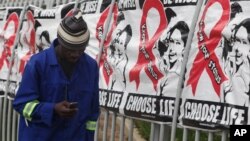As South Africa joins the rest of the world in commemorating World AIDS Day, experts say the country's women below age 25 have a high HIV infection rate and studies show they are getting the virus from older men.
Lolobrigitha Tsupa, 30, was 23 when she learned she was HIV positive. She was looking for a man who could satisfy her craving for a fast and high-flying life.
But Tsupa said she got more than that. "I met this man who had money, drove nice cars, and the man was very old, old enough to be my father. He would buy me things, gifts, and he would take me out," she said. "That is the life I wanted to live and I did not have that at home. Anyway, that is where I got the virus from."
Tsupa’s story is similar to that of 28-year-old Brenda Masango.
Masango said she discovered she was HIV positive in 2007, while still a student at the University of Tswane. She said it all started when her parents cut their financial support to punish her bad behavior.
"I had to buy clothes for myself" and cover food costs at school, she said. "So, I dated a bigger person to me, a man, so it came where he said to me, 'I am giving you money and I give you a lot of money,' so I ended up having sex with that guy not using a condom. So, I think that is where I contracted HIV."
Infection rate
Experts say 6.4 million of South Africa’s 50 million people are HIV positive. They say females between the ages of 15 and 24 are four times more likely to contract HIV than their male counterparts. HIV prevalence in young women is rising at a faster rate than in young men, they add.
The infection rate among females 15 to 19 is 5.6 percent.
The gap grows even wider in the 20 to 24 age category. Studies show women in this group become HIV positive five years earlier than their male counterparts.
Among people age 20 to 24, the infection rate is 5.1 percent among males and 17.4 percent among females.
'Worrisome' statistics
Dr. Fareed Abdullah, chief executive officer of the South African National Aids Council, said the statistics are worrisome.
"About one quarter of all new infections [are] in young women between the ages of 15 and 24, and we believe that they are being infected by older men in exchange for gifts, for clothing, what we call transactional sex, because older men have a higher accumulated risk of HIV," said Abdullah.
Abdullah said South Africa needs multiple programs to deal with intergenerational sex, including poverty-alleviation programs and sex education campaigns directed at young girls.
Portia Serote is the national coordinator at the Treatment Action Campaign, a Johannesburg-based HIV/AIDS organization that advocates awareness and treatment. She blamed young girls' high rate of HIV infection on government policy that allows girls as young as 12 to have sex, use contraceptives and abort unwanted pregnancies without the consent of their parents.
"It more like we are setting them [up] for a failure to be HIV positive," Serote said. When a young girl contracts the disease, especially if she becomes pregnant, "it becomes a mess. ... We push them to have sex, but we are not giving then a space to practice the responsibility to the rights that we are giving them."
But it's not all gloom and doom for South Africa, experts say. The country has the largest anti-retroviral treatment program in the world and has drastically reduced its mother-to-child HIV infection rate from 8 percent in 2008 to about 2 percent.









